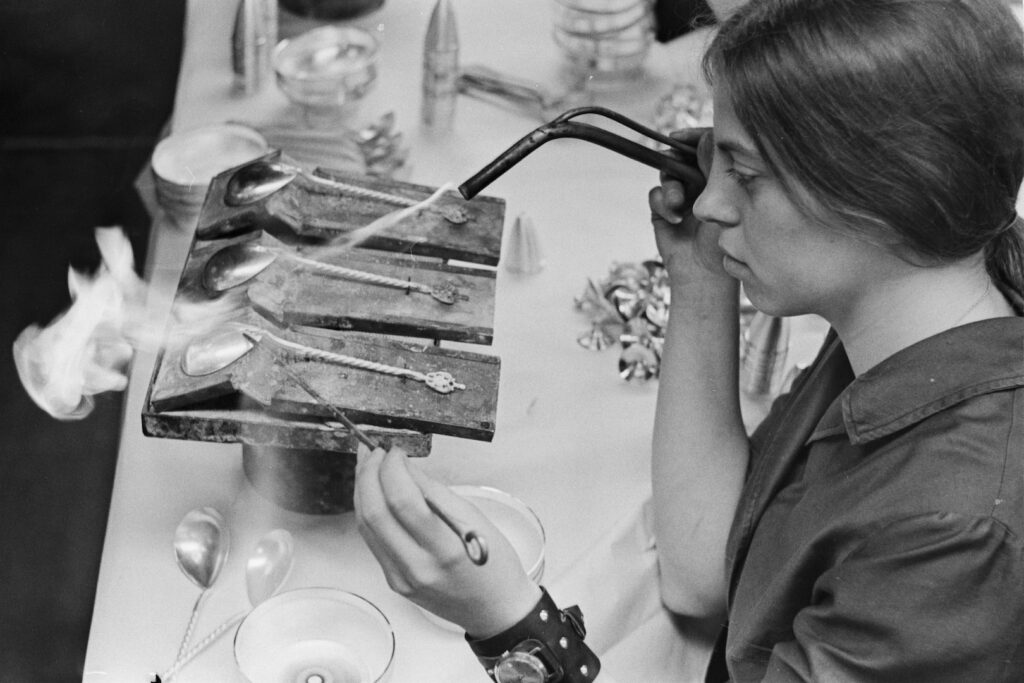ETDM presents Local Beauty: Tallinn Jewellery Factory, a major survey exhibition introducing a legacy of Estonian silverware and jewellery
2.5.2023
Exhibition

The exhibition Local Beauty: Tallinn Jewellery Factory, open to the public from 5 May, introduces the legacy of a company that played a pivotal role in Estonia’s design history, and whose austere and romantic style of tableware, cutlery and jewellery shaped the look of local everyday life for decades.
“The exhibition focuses on the work produced by the factory from the 1950s, when the first artists were enlisted, until the moment both the state regime and the market changed,” explains co-curator Kai Lobjakas. “Over the years, the factory produced silverware, both dishware and cutlery sets, as well as jewellery. Jewellery was initially designed and produced here for a decade from the early 1950s and then again from 1977.”
She adds that the current exhibition is a kind of open archive, which is sure to offer many joyful rediscoveries for local visitors, as productions by the Jewellery Factory were once found in most homes in the country. The museum wishes to give design enthusiasts and collectors alike the opportunity to get to know the time and the artists behind the objects that every local has encountered during their life and some use to this day – as was the case with Local Beauty: The Tarbeklaas Glass Factory, the previous exhibition in the series.
From 1951 onwards, nearly 15 artists, most of whom had graduated from the decorative metalwork department of the State Art Institute, worked for various lengths of time as designers at the Jewellery Factory. The most extensive creative contribution to the selection of products produced by the factory was made by Liidia Elken, with Irena Loit, Igor Balašov, Urve Küttner, Leida Ilo, Kersti Rosenstrauch and others close behind her. Their contribution was determined by the nature of the factory’s production, as artists did not have the opportunity to specialise and were asked to design tableware as well as jewellery.
“During the preparation of the exhibition, it has been extraordinary to witness the organisation of the jewellery production process, which requires specific skills and continues in the factory today. Despite the mechanisation, a surprising amount of craftsmanship is required to make each item, and the exhibition also introduces this aspect,” explains Ketli Tiitsar, the other co-curator of the exhibition.
A standout among the artists involved in the exhibition is Liidia Elken, who worked at the Jewellery Factory for 55 years, during which time she significantly shaped the face of the factory’s production. The iconic designs of several other artists are also displayed, including Leida Ilo’s legendary children’s spoons and Urve Küttner’s Elegant and Arnika series. Visitors also get the chance to see the Jewellery Factory artists’ own creative work, which offers a glimpse into the other side of their art practice, which often ran parallel to their work for the factory.
Tallinn Jewellery Factory was founded in 1959 and has had several names over its lifetime. During the longest period, from 1959 to 1978, the company operated under the name Tallinn Jewellery Factory. The predecessor of the Jewellery Factory is considered to be the Roman Tavast factory for precious metal items and badges, which also produced tableware and jewellery alongside its main focus of emblems. It was founded in 1923 and nationalised in 1940 by the Soviet government. The Tavast company buildings and equipment on Pärnu Road survived the war, and under the new regime work continued in the same premises and with many of the same employees, machinery and designs. In the second half of the 1970s, a new production building was built in Mustamäe.
The successor of Tallinn Jewellery Factory, OÜ Juveel currently operates in the same building. There are currently no artists working at the company, but they still produce several iconic cutlery sets, among other things. Collaboration with designers has occurred in the production of the “Lummus” series of jewellery collections, which began in 2015.
In 1993, Roman Tavast’s son re-established his father’s company Roman Tavast OÜ, which is still operating today.
The exhibition will remain open until 1 October 2023.
As part of the exhibition’s audience programme, the museum will organise guided tours to OÜ Juveel’s production building in Mustamäe. The first two tours will take place on 16 May at 12:00 and 30 May at 12:00 ( In Estonian). Tickets are available HERE.
Curators: Kai Lobjakas and Ketli Tiitsar
Designer: Kaire Rannik
Graphic designers: Valter Jakovski / Ruum 414
Sound: Janek Murd
Camera: Virko Veskoja
Exhibition is supported by: OÜ Juveel, Cultural Endowment of Estonia